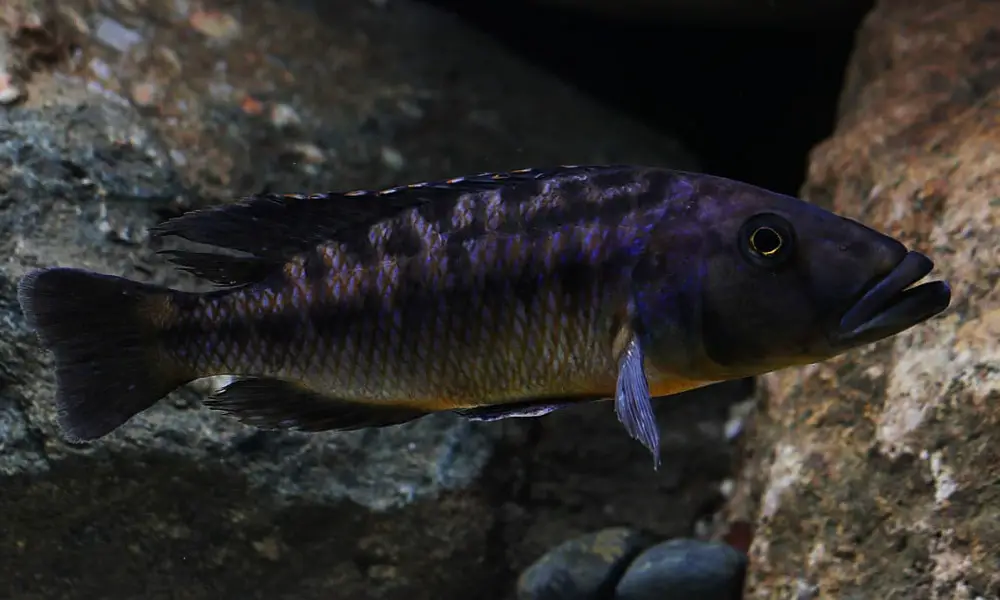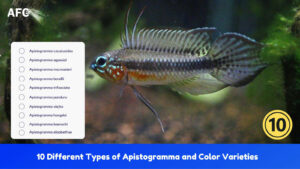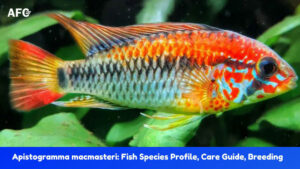For people who consider themselves a Malawi Cichlid fanatic, then the Big Mouth Hap Cichlid (Tyrannochromis Macrostoma) is a fish you can‘t miss out on.
These fish are ambush predators in nature, moving around rocks and in crevices, ambushing for an unsuspecting meal to swim by before attacking. They’re just so darn entertaining to watch in a predator hap aquarium during the feeding time.
These large haps are rarely seen in the aquarium trade. If you are lucky enough to have Big Mouth Hap Cichlids, they definitely require some experience to care for.
This guide will go over everything you need to know about Tyrannochromis Macrostoma care, including their size, diet, and tank mates.
Species Summary
The Big Mouth Hap Cichlid, known scientifically as Tyrannochromis Macrostoma, is endemic to Lake Malawi, where they are found over rocky areas in shallow water.
It was described as Haplochromis macrostoma by Regan in 1922 and now is listed on the IUCN Red List as Least Concern (LC).
This fish belongs to a small genus Tyrannochromis, which currently has only four species, including T. macrostoma, T. maculiceps, T. nigriventer, and T. polyodon. Only T. macrostoma and T.polyodon are occasionally available in the hobby with a pretty expensive price tag.
A fast and powerful swimmer, the Big Mouth Hap Cichlid is one of the largest Haps, only recommended for advanced African Cichlid Keepers.
| Scientific Name: | Tyrannochromis Macrostoma |
| Common Name: | Big Mouth Hap Cichlid |
| IUCN Red List: | Least Concern (LC) |
| Care Level: | Advanced |
| Origin: | Lake Malawi, African |
| Lifespan: | 7 – 10 years |
| Max Size: | 14 inches (35 cm) |
| Temperature: | 75-82°F (24-28°C) |
| PH: | 7.6-8.8 |
| Water hardness: | 10 to 25 KH |
| Diet: | Carnivorous |
| Minimum Tank Size: | 125 gallons (72″ x 18″ x 21″) |
| Temperament: | Aggressive |
Appearance

These beautiful Malawi Haps often show bright colors with striking iridescent patterns, and the Big Mouth Haps are no different. They have a classic stocky and elongated body like many other types of Haps.
Like many other African Cichlid types, there are several natural color variations of the Tyrannochromis Macrostoma that depend on the location they are found in Lake Malawi. They may have a totally different color morph from each other.
For example, a male from Gome Rock has an electric blue body with orange or yellow anal, pelvic and caudal fins, while a male from Nakantenga Island features a black base with light blue dorsal, pectoral, and caudal fins.
Females are less colorful than males, but they still have their own beauty with drab brown colors.
Macrostoma Vs. T. nigriventer
The juvenile T. Macrostoma is easily confused with its close relative, T. nigriventer, but there are actually some noticeable differences between adults.
The most obvious difference is that adult T. Macrostoma develops a dark belly. Additionally, both species have a bulge on their head between the eyes and lip, but the one on T. Macrostoma is closer to the eye, while on T. nigriventer, it is at the midpoint.
Lifespan
The average lemon tetra size is somewhere between 7 to 10 years with proper care. While there are plenty of specimens that can outlive, it’s usually a mix of luck and good care that leads to a long life.
Like any other Cichlids from Lake Malawi, the Tyrannochromis Macrostoma’s lifespan is heavily impacted by its living conditions. A well-maintained aquarium with optimal water parameters and a healthy diet will help these fish to reach their maximum potential age.
Tyrannochromis Macrostoma Size
T. macrostoma is one of the largest predators of Haps. They can reach up to 12 inches (30 cm) in the wild. In captivity, these fish are sometimes a bit bigger, with a maximum size of around 14 inches (35 cm).
Care & Aquarium Setup
Understand that these Tyrannochromis Macrostoma males are very aggressive. More precisely speaking, they are frequent killers when they reach maturity. It is not uncommon for a Big Mouth Hap to kill any tank mates that are small enough to be eaten.
Big Mouth Hap Cichlids care is only recommended for Malawi Cichlid aquarists who have a bit of experience and enjoy a challenge. Due to their large size and feisty behavior, you may get a huge problem on your hand if you’re not prepared for it.
Big Mouth Hap Tank Size
The recommended minimum tank size for a single adult Big Mouth Hap Cichlid is 125 gallons (72″ x 18″ x 21″), but a larger aquarium is always better. If you want to keep a group of one male and several females, aim for a tank of at least 180 gallons (72″ x 24″ x 25″).
Since they grow relatively fast, it is recommended to keep them in a species-only aquarium or with other fish that are too big to be eaten.
Water Parameters
When it comes to water parameters, the key to keeping Tyrannochromis Macrostoma happy and healthy is to recreate their natural habitat as closely as possible. In the wild, these fish inhabit shallow waters in rocky areas.
They come from Lake Malawi in Africa, where the water temperature is warmer and alkaline. Being the fifth largest freshwater lake in the world, Lake Malawi is known for its clear and warm waters. Plus, the water chemistry of the lake is extremely stable.
The ideal water parameters for Big Mouth Hap Cichlids are:
- pH: 7.6-8.8
- Temperature: 75-82°F (24-28°C)
- Water Hardness: 10-25°H
- Ammonia: 0ppm
- Nitrite: 0ppm
- Nitrate: <20ppm
Due to the unique water conditions of their natural habitat, Cichlids from these Rift lakes have some salt tolerance, but they are still freshwater fish and should not be kept in a full brackish water tank.
As the poor water conditions and low oxygen levels result in stress, and more stress makes these fish more susceptible to Malawi bloat, it’s easy to see why it is essential to maintain optimal water parameters in their aquarium.
Sticking to a regular maintenance routine, including 30-50% water changes every week to avoid stress. Frequent water changes also play an important role in their growth rate.
Large predatory fish means they produce waste more frequently than any others, so a powerful filtration system is a must. A high-performance canister filter or a Sump Filter will do a great job filtering the water and keeping it clean.
I was most impressed by the Fluval FX4 that I have used for more than 15 years. After trying those HOB filters and other brands, this one is such a joy. It’s simple to assemble, quiet, and very efficient.
- Enhanced Performance: Multi-stage filter pumps out 700 US Gal (2,650 L) of water per hour, with the...
- Self-Starting: Just add water, plug in and Smart Pump technology will take over. Any trapped air is...
- Multi-functional Utility Valve: Drain at the base makes it possible to empty the canister and perform...
- 4-Stage Filtration: Four removable filter baskets eliminate water bypass and hold up to 1 US Gal (3.9 L)...
- Compact and Quiet Design: FX4 canister filter stands 16.5” (42 cm) tall and easily fits under most...
Substrate & Decor
As with most Lake Malawi cichlids living in rocky habitats, Big Mouth Haps are most comfortable in an aquarium with abundant caves and crevices. Using dragon stones or other types of limestone to create shelters not only looks great but also helps keep the ph up.
Make sure these structures are constructed securely to avoid any accidents. Big Mouth Haps are not the most delicate fish, but they can be quite active and dig around and underneath them.
Diet
Tyrannochromis Macrostoma is a piscivore that feeds primarily on smaller Mbunas in the wild, which can be snapped up easily thanks to their large mouths. In the aquarium, they will accept freeze-dried foods, but these should not as the primary base of their diet.
You can train them to eat dead foods such as cockle, lancefish, prawns, and mussels.
Overfeeding with predators like this is quite common because this is the best time to observe their hunting behavior. But be aware that this can contribute to Malawi Bloat.
Big Mouth Hap Cichlid Tank Mates
A predatory species with a large mouth is definitely not a community fish.
They are better off being kept in a group of only one male and 2 to 3 females in a sizeable species-only aquarium to show the best color. Two males will fight unless the tank size is enormous.
Smaller fish under 5 inches, like Mbunas – their natural diet, should be avoided.
Most predator Haps typically don’t do well with other large haps, even those from different genera, with the exception of those that come from the same region.
Tyrannochromis Macrostoma Breeding
Unfortunately, there is no record to show that Tyrannochromis Macrostoma has been bred in captivity.
In the wild, they are substrate spawners. Males dig large pits and defend against any intruders. Females lay their eggs in the pits, and after hatching, the fry are guarded by both females for more than 3 weeks when they reach about 1.5 inches (4.0 cm).
Wrapping It Up
Now that you have a better understanding of Big Mouth Hap Cichlids’ care. Like all African Cichlids, they have some specific care needs that must be met to ensure they thrive.
Tyrannochromis Macrostoma is not a common fish in the aquarium trade. So if you’re lucky enough to find one, don’t hesitate to add this beautiful fish to your Malawi Predator tank.
If you have any suggestions on how to better care for Big Mouth Hap Cichlids or have any questions, please leave a comment below. We would love to hear from you.






